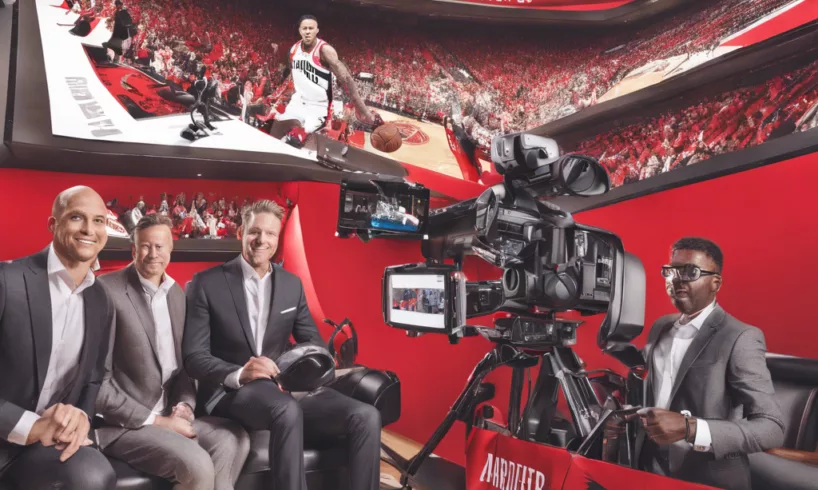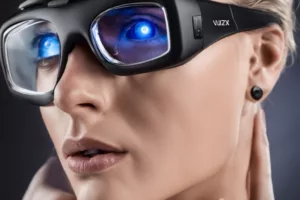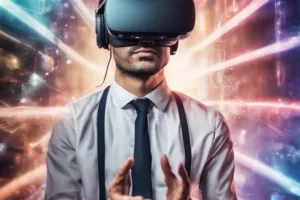
Portland Trail Blazers Partner with Disguise to Revolutionize Sports Broadcasting with Augmented Reality Graphics from Handheld Cameras
The sports broadcasting landscape is set for a dramatic transformation as the Portland Trail Blazers make a slam dunk in the world of technology. The NBA team has partnered with disguise, a global leader in live event visuals, to broadcast augmented reality (AR) graphics for the first time, using a handheld camera during a basketball game. This groundbreaking development promises to redefine the viewer experience, bringing fans closer to the action than ever before.
A Game-Changing Collaboration
The Trail Blazers, one of only five NBA teams that produce all their live broadcasts in-house, teamed up with disguise to work on this ambitious project. Over six weeks, the two teams worked tirelessly to install tracking hardware in the Moda Center basketball arena, using the RedSpy tracking system with an infrared camera pointing to markers on the arena's ceiling. The next step involved installing a disguised px+ media server to render real-time Unreal Engine AR graphics with live data feed integration.
The Technology Behind the Magic
To control the graphics, disguise Gateway was integrated with Viz Trio, along with disguise's Porta solution for native Unreal Engine control. The Creative Services team at disguise provided data visualization, concept development, Unreal Engine graphics implementation, and data integration services. The result? A breathtaking AR experience that brings fans right into the heart of the action.
Transforming the Viewing Experience
Thanks to this innovative technology, Trail Blazers fans can now see on-air graphics elements in the arena alongside the players. These graphics present live player and game information in a more dynamic, easy-to-read format than traditional lower-thirds graphics. Even more impressively, an AR line graph displays the team's shooting percentage throughout the game, updating with each new field goal attempt.
The Future of Sports Broadcasting
This groundbreaking endeavor is just the start for the Trail Blazers' broadcast team. They envision a future where fans can enjoy an immersive experience replicating the energy and intensity of being in the stands — all from the comfort of their homes. The team is already exploring the integration of more cameras into the AR world and the incorporation of player tracking into their graphics.
The Trail Blazers' pioneering use of AR in sports broadcasting marks a significant step forward in the industry. By integrating live game data into an AR experience, the team is pushing the boundaries of what is possible, creating an immersive viewer experience that brings fans closer to the game than ever. As more teams adopt this technology, the future of sports broadcasting looks set to be an exciting blend of reality and augmented reality, offering unparalleled access to the action on the court.
The Trail Blazers' groundbreaking use of augmented reality (AR) in sports broadcasting has undoubtedly revolutionized the industry. Going beyond traditional broadcasting methods, the team has managed to seamlessly integrate live game data into an immersive AR experience, taking viewers on a thrilling journey that brings them closer to the game than ever before. This innovative approach has not only captivated fans but has also opened up new possibilities for sports broadcasting as a whole.
Immersive Viewer Experience
One of the primary goals of any sports broadcast is to provide viewers with an immersive experience that makes them feel like they are right there in the heart of the action. In the past, this was achieved through high-definition cameras, slow-motion replays, and commentary from expert analysts. However, with the advent of augmented reality (AR), the team behind this innovative broadcasting method has taken things to a whole new level. By seamlessly integrating live game data into an AR experience, viewers are now able to see statistics, player profiles, and even real-time analysis from the comfort of their own homes. The introduction of augmented reality has revolutionized the way we consume sports broadcasts. Gone are the days of passively watching a game unfold on our screens; now, we can actively engage with the action in real-time. One of the key advantages of AR in sports broadcasting is the ability to provide viewers with live game data. As a basketball fan, for example, I can now see player statistics and analytics pop up on my screen as they make their moves on the

George Smith, with over a decade in tech journalism, excels in breaking down emerging tech trends. His work, spanning tech blogs and print, combines in-depth analysis with clarity, appealing to a wide readership. George's pieces often explore technology's societal impact, showcasing his foresight in industry trends.







